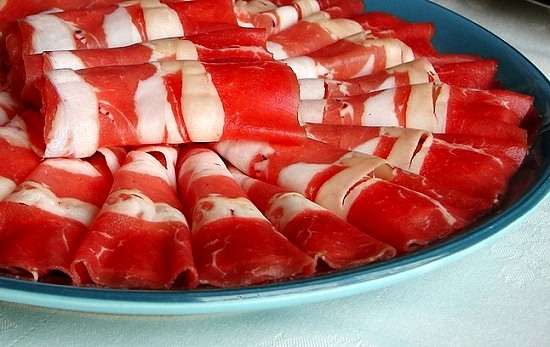Yellow Beef Fat
Another Advantage of Grass Fed Beef!

Image Credit: JB
"Why is grass fed beef fat yellowish instead of bright white?"
Fat color is a function of what kind of vitamins are present in the cow's diet.
The key ingredient that makes grass fed beef fat look yellow instead of white is beta-carotene.
Beta-carotene is a natural form of Vitamin A - an essential nutrient - which the body can convert to Vitamin A as needed. Beta-carotene is also an antioxidant, important for protecting the body against free-radicals.
Beta-carotene is a naturally-occurring plant pigment. It is what gives many fruits and vegetables their orange or yellow color (like carrots, squash, pumpkins, and grapefruit).
And it occurs naturally in many pasture grasses and legumes (even though most of these are green rather than orange or yellow).
The high beta-carotene content of grass is the reason why cattle finished on a grass-rich diet will have more beta-carotene in their fat, which you will benefit from when you eat their meat.
Yellow Beef Fat Is Healthier And Tastier!
Beta-carotene is fat soluble. When cattle consume beta-carotene-rich foods, it is stored in their fat. And likewise, when we eat beta-carotene-rich foods (like carrots, pumpkins, or beef with beta-carotene stored in the fat) then we transfer that beta-carotene to our own body fat reserves.
Grass contains beta-carotene. Grain does not.
So don't knock the yellowish color of grass fed fat - it's actually a sign that it is good for you!
And not only is it good for you, but it is also one of the contributing micro-nutrients that gives grass fed beef fat its superior flavor.
By contrast, cattle finished on grain will not have much beta-carotene in their diet and consequently their fat will also be missing the wonderful yellowish color. The only grain that is an exception to this rule is corn, which contains some beta-carotene, so cattle finished on a high corn diet will also have somewhat yellowish fat, though still not as much as cattle finished on grass.
Natural vitamin sources beat supplements!
The yellowish tint to grass fed beef fat is a signal showing that it is a healthy natural source of beta-carotene for you, which your body can convert to Vitamin A as needed.
Eating beta-carotene-rich grass fed beef is a far healthier way to increase your Vitamin-A intake than popping Vitamin-A supplements to make up for the lack of beta-carotene in grain fed beef. Not only is the natural food source healthier for you, but using Vitamin-A supplement pills may actually be seriously damaging your health.
The BBC Horizon documentary, called The Truth About Vitamins (2004), does a fantastic job of explaining the science behind why vitamin supplements generally don't work and actually may be far more harmful than good (unless they are specifically prescribed by a doctor to address a medical condition).
|
Here's the YouTube link to watch BBC Horizon - The Truth About Vitamins (the link opens to the YouTube search results - there are generally at least 2 or 3 unofficial uploads of the 49 minute documentary available. |
After watching the documentary, our family cheerfully purged our fridge of all vitamin supplements. It also silenced that nagging little voice in the back of my mind that suggested that I wasn't taking good care of my health unless I was popping some kind of vitamin supplements.
However, it has made our family extra keen to choose grass fed beef over grain fed beef since it is a natural food-based source of many vitamins and minerals like beta-carotene and omega-3 fatty acids.
Have you noticed a color difference in your beef fat?
Do you notice a difference in the color and flavor of grass fed versus grain fed beef fat? Does the fat from grass fed beef improve the flavors of your favorite recipes?
Share your comments below! And if you enjoyed this article, please use the social media buttons to share it with your friends!
|
Share: |
|


